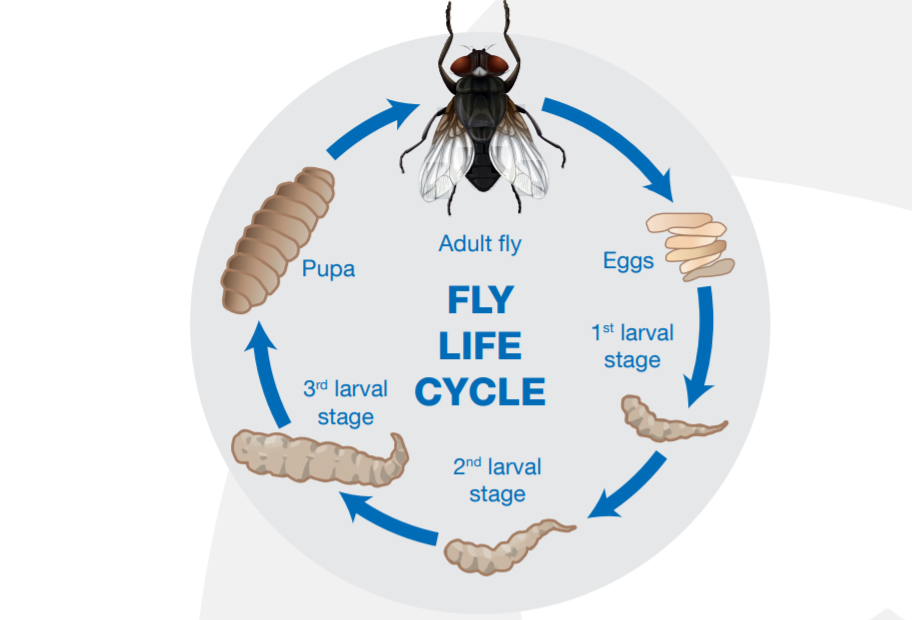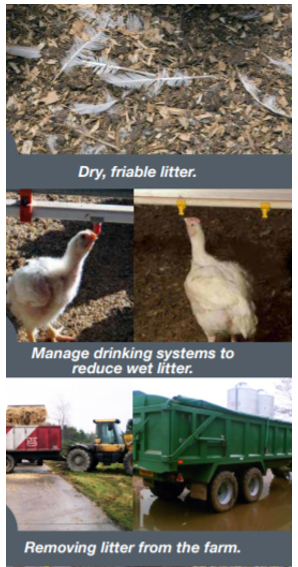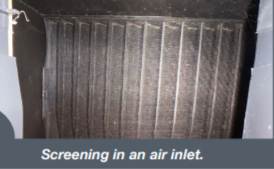



Best practice on the farm: Fly control
This comprehensive guide, produced by Aviagen, gives farm managers clear and actionable information to control the incidence of flies on the poultry farm.
Introduction
Flies pose a health risk for humans and poultry. They are carriers of Salmonella, Pasteurella, Campylobacter and E. Coli which have a negative effect on poultry flocks and farm personnel. The speed of fly reproduction can vary depending on environmental conditions such as warmth, moisture and food sources, but it is not uncommon to have 5 - 6 generations during a single summer breeding season.

Best practice for fly control
The key to avoiding fly infestations is managing water and moisture in the litter. Farms which keep dry litter rarely experience serious fly infestations.
A successful fly control program ensures moisture is controlled within the house and fly breeding sites are eliminated. Insecticides can help to provide temporary reductions in fly populations but cannot be the only method of effective fly management.
Use an integrated fly management program involving techniques such as:
- Sanitation and fly exclusion
- Chemical methods of fly control (insecticides)
- Fly traps
Sanitation and fly exclusion
1) Sanitation is the first measure of defence against flies in the poultry house.

Whenever possible feed, litter, broken eggs and mortalities on which flies lay their eggs must be removed.
Litter remaining on the farm should be managed so that it remains dry and friable.
- Managing the height of drinking systems and checking water flow rates will help reduce the incidence of wet litter.
- Drinking systems should be checked regularly to ensure that there are no leaks.
Litter removed at depletion should not be stored on the farm or spread on land adjacent to the farm. It must be removed with a trailer covered in a tarpaulin to a distance of at least 3.2 km (2 miles) away from the farm and disposed of in accordance with government regulations.
Feed spills should be cleared up immediately.
Flock mortalities should be removed from the house as soon as they are discovered.
Any broken eggs from the breeder house should be removed immediately to prevent attracting flies.
2) Flies can also be excluded from the house with the use of screens or fans.

Extraction fans that direct an outward airflow will prevent flies from entering the house.
Screens should be placed in entrance doors, windows and inlets.
- Mesh screening is commonly made from materials such as stainless steel, coated steel, PVC and aluminium.
- The screen hole size should be between 0.88mm and 1.22mm (0.03 and 0.05 inches) to effectively exclude flies.
Chemical methods of fly control
1) Insecticides are an effective method of reducing initial fly burden and are a key component of a good biosecurity program.
Insecticide baits typically consist of a mixture of insecticide, sugar and pheromone attractants. There are two types of insecticide used in the poultry industry residual and non-residual.
Residual insecticides
Residual insecticides should only be applied in empty houses.
- Houses should be thoroughly cleaned and disinfected before insecticides are applied.
- Protective clothing, face mask, gloves, hat and eye protection should be worn while applying insecticide.
- Mix the insecticide concentrate with clean water according to the manufacturer's recommendations and only use clean sprayers to apply the insecticide.
- Apply to non-absorbent house surfaces such as hard wood, painted or coated walls.
- Leave the area and allow the insecticide to dry thoroughly (2-3 hours).
- After drying, these products are harmless to poultry and humans.
- Insecticides remain effective for 2-3 months.
Non-residual insecticides
Non-residual insecticides are only useful at the time of application and have no long term effectiveness. They are best used in situations where the initial removal of a large adult fly population is necessary. In this case, a non-residual insecticide should be used before the application of a longer lasting residual insecticide.
- As with residual insecticides, this application is only suitable to treat the inside of an empty house.
- Thermal fogging machines can be used to distribute the non-residual insecticide throughout the house.
2) Larvicides are also an effective method of chemical fly control.
Larvicides control only the fly larvae and are usually applied as a spray or distribution of granules on the manure beneath the slats in the breeder house or directly onto litter in the broiler houses. Some things to consider when applying larvicides are:
They are more effective on the younger larvae than older larvae so timing is important. The best time to apply the first treatment is 2 weeks after birds are placed into the house.
- Larvicides are slow acting and can take 1-2 weeks to take effect.
- Due to the risk of flies developing resistance, only two full treatments of litter within the life of each flock is recommended.
3) Use insecticide products in rotation
- Rotation of insecticides with a different mode of action or active ingredients will reduce the risk of resistance.
- Unless otherwise directed, switch to an insecticide with a different mode of action every 2-3 fly generations (approximately every 6-9 weeks).
4) Paint on fly attractants
- Contain attractants that encourage flies to land on the application site.
- Kills flies within minutes of contact, including flies that are resistant to other chemicals.
- Paint on attractants cannot be used in areas where birds can access them, but may be used inside the house outside of bird pens.
- Apply attractant to clean surfaces where flies rest: walls, window ledges and fixtures.
- Paint attractants can also be painted onto bags, cardboard or fabric and hung in areas of heavy fly infestation.
- Avoid applying in cool windy locations, such as near fans or cool cells, because flies generally prefer warmer locations with less air movement.
- Paint on fly attractants should be re-applied every 3-5 days, depending on the level of infestation.
Other methods of fly control
Hanging fly paper with adhesive
Placed mainly in amenity buildings and not in production houses.
- Fly paper is coated with a sweet, fragrant, extremely sticky, non-toxic substance that traps flies when they land on it.
- Fly paper loses its effectiveness over time when it dries or becomes covered in dust, and should be replaced regularly. Depending on the fly population size, fly paper may last from a few days up to 2 weeks.
Ultraviolet flay zappers
Used in reception area, processing plants, egg rooms and other non-bird areas.
- Electric zappers attract flies with long-wave length ultraviolet light and the eliminate them with electrocution.
- Depending on the machine specifications, ultraviolet fly zappers are suitable for indoor and outdoor use.
- Electric fly zapper units are effective during the day and night, and draw insects from a coverage of up to 150m2 (1615ft).









